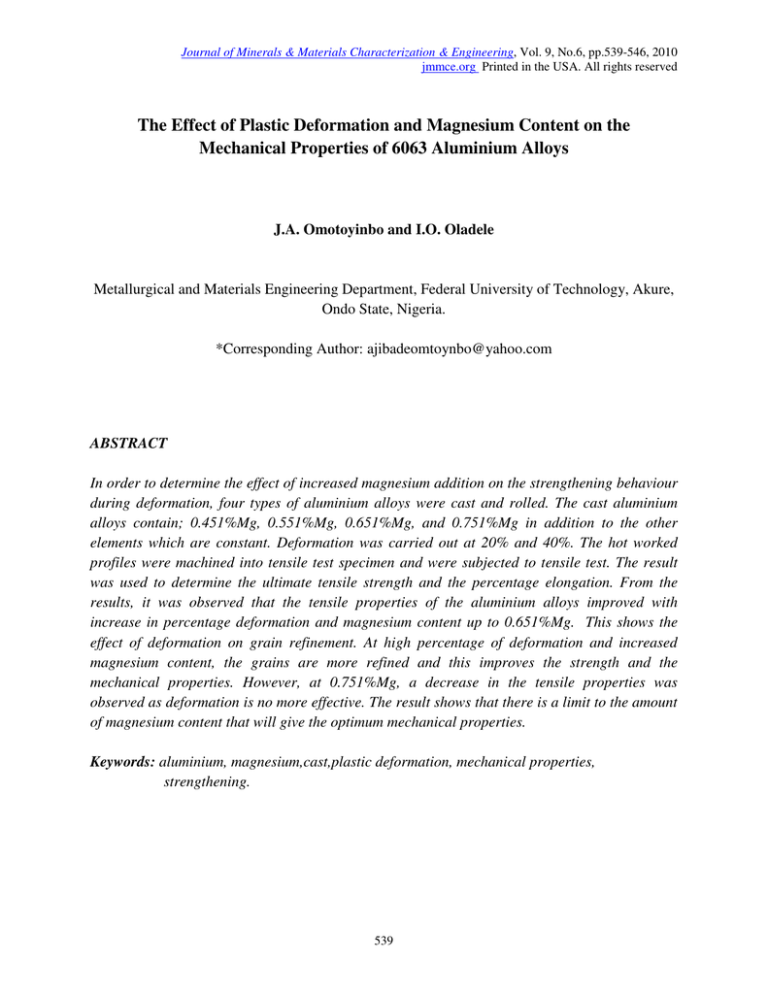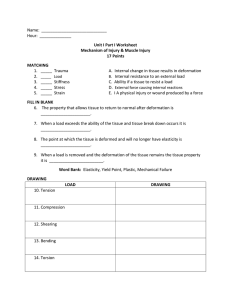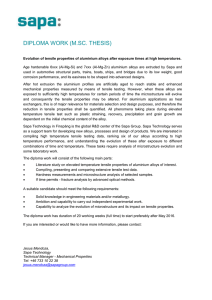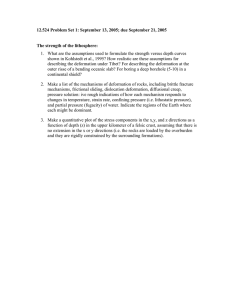
Journal of Minerals & Materials Characterization & Engineering, Vol. 9, No.6, pp.539-546, 2010
jmmce.org Printed in the USA. All rights reserved
The Effect of Plastic Deformation and Magnesium Content on the
Mechanical Properties of 6063 Aluminium Alloys
J.A. Omotoyinbo and I.O. Oladele
Metallurgical and Materials Engineering Department, Federal University of Technology, Akure,
Ondo State, Nigeria.
*Corresponding Author: ajibadeomtoynbo@yahoo.com
ABSTRACT
In order to determine the effect of increased magnesium addition on the strengthening behaviour
during deformation, four types of aluminium alloys were cast and rolled. The cast aluminium
alloys contain; 0.451%Mg, 0.551%Mg, 0.651%Mg, and 0.751%Mg in addition to the other
elements which are constant. Deformation was carried out at 20% and 40%. The hot worked
profiles were machined into tensile test specimen and were subjected to tensile test. The result
was used to determine the ultimate tensile strength and the percentage elongation. From the
results, it was observed that the tensile properties of the aluminium alloys improved with
increase in percentage deformation and magnesium content up to 0.651%Mg. This shows the
effect of deformation on grain refinement. At high percentage of deformation and increased
magnesium content, the grains are more refined and this improves the strength and the
mechanical properties. However, at 0.751%Mg, a decrease in the tensile properties was
observed as deformation is no more effective. The result shows that there is a limit to the amount
of magnesium content that will give the optimum mechanical properties.
Keywords: aluminium, magnesium,cast,plastic deformation, mechanical properties,
strengthening.
539
540
J.A. Omotoyinbo and I.O. Oladele
Vol.9, No.6
1. INTRODUCTION
Pure aluminium is a weak and ductile material. However, the presence of a relatively small
percentage of impurities in aluminium considerably increases the tensile strength and hardness of
the material (Bolton, 1999).
The mechanical properties of aluminium and its alloys depend not on the purity of aluminium
but on the amount of work to which it has been subjected. The effect of working is to fragment
the grains. This results in an increase in tensile strength and hardness and a decrease in ductility
(Bolton, 1999).
The 6000 series alloys have recently found increased application in automotive and construction
industry. Therefore, several research works have been undertaken to strengthen the alloys either
by small addition of copper, magnesium, zinc and/or silicon (Moons, et al, 1996) or by a
predeformation treatment (Matsuda, et al, 1999).
The development of Al-Mg-Si alloys for light structures has led to an increasing market for
extrusions of intricate shape, medium strength and good toughness. These alloys are required to
meet specific tensile properties and fatigue strength, welding characteristics and formability
(Kemal et al, 2005).
In this paper is the result of the findings on the effect of deformation and magnesium content on
the tensile properties of 6063alloys.
2. EXPERIMENTAL PROCEDURE
Four alloys of the compositions given in Table 1 were cast in form of rods of dimension
5000mmx12mm.
Table 1. Chemical Composition of the Aluminium Alloys. (Wt %)
Alloys/Comp. Fe
Si
Mn
Cu
Zn
Ti
Mg
I
0.336 0.456 0.037 0.050 0.127 0.014 0.451
II
0.336 0.456 0.037 0.050 0.127 0.014 0.551
III
0.336 0.456 0.037 0.050 0.127 0.014 0.651
IV
0.336 0.456 0.037 0.050 0.127 0.014 0.751
Sn
0.01
0.01
0.01
0.01
Pb
0.08
0.08
0.08
0.08
Al
98.44
97.89
97.79
97.69
The aluminium alloys were hot worked by rolling them at 20% and 40% deformation after
holding in the furnace at 4500C and soaked for 30 minutes. The deformed rods were machined
on the lathe to tensile specimens and tensiometer was used to carry out the test.
Vol.9, No.6
The Effect of Plastic Deformation and Magnesium Content
541
2.1 Tensile Test
The specimen was clamped to the teeth of the tensiometer and load was gradually applied
manually. The value of the applied load was indicated by the pointer in the mercury bulb. The
effect of this load was also displayed on the graph sheet that was fixed at one end of the machine.
The applied load stopped immediately the specimen breaks and the graph show the relation
between the load and the extension produced. The percentage elongation was determined from
the specimen with the aid of vernier caliper. The percentage elongation of a test piece after
breaking is used as a measure of ductility;
Percentage elongation ═ final length – initial length x100%
(Bolton, 1999)
Initial length
3. RESULTS AND DISCUSSION
Deformation is one of the most important parameters in increasing the mechanical properties of
aluminium and its alloys. Figures1a, 2a and 3a show the dependence of the ultimate tensile
strength of 6063 alloys on the degree of deformation.
3.1 Aluminium Alloy Sample with 0.451%Mg
Figure 1a shows the average stress-strain curve of the samples. Samples deformed at 40% have
increased tensile properties of 241.34N/mm2 UTS than those deformed at 20% with
202.24N/mm2 UTS.
542
J.A. Omotoyinbo and I.O. Oladele
Vol.9, No.6
Figure 1b shows the graph of percentage elongation of the deformed samples. Samples deformed
at 20% have high percentage elongation of 4.40% than those samples deformed at 40% with
3.95% elongation.
3.2 Aluminium Alloy Sample with 0.551%Mg
Figure 2a shows the average stress-strain curve of the samples. Samples deformed at 40% have
increased tensile properties 251.67N/mm2 UTS than those deformed at 20%that has
196.73N/mm2 UTS.
Vol.9, No.6
The Effect of Plastic Deformation and Magnesium Content
543
Figure 2b shows the graph of percentage elongation of the deformed samples. Samples deformed
at 20% have high percentage elongation of 4.40% than those samples deformed at 40% with
3.90% elongation.
3.3 Aluminium Alloy Sample with 0.651%Mg
Figure 3a shows the average stress-strain curve of the samples. Samples deformed at 40% have
increased tensile properties of 258.03N/mm2 UTS than those deformed at 20% which has
215.10N/mm2 UTS.
544
J.A. Omotoyinbo and I.O. Oladele
Vol.9, No.6
Figure 3b shows the graph of percentage elongation of the deformed samples. Samples deformed
at 20% have high percentage elongation of 3.48% than those samples deformed at 40% with
3.13% elongation.
3.4 Aluminium Alloy Sample with 0.751%Mg
Figure 4a shows the average stress-strain curve of the samples. Both samples that were deformed
at 40% and 20% have 179.14N/mm2 and 180.64N/mm2 UTS respectively.They experienced
almost the same increase in tensile properties.
Vol.9, No.6
The Effect of Plastic Deformation and Magnesium Content
545
Figure 4b shows the graph of percentage elongation of the deformed samples. Samples deformed
at 40% have high percentage elongation of 2.50% than those samples deformed at 20% which
has 1.70% elongation. This shows that the samples deformed at 40% is more ductile than the first
three samples that were deformed at 40%.
The progressive increase in the tensile strength as the magnesium content increase from 0.451%
to 0.651%Mg content as shown in Figures1a, 2a, 3a that, both the percentage deformation and
magnesium content affect the mechanical properties of 6063 aluminium alloys.
When the alloying element was increase to 0.751%Mg, deterioration in the tensile properties was
observed. At this composition, 40% deformation causes a small decrease in the tensile properties
than what obtained at 20% deformation. (Figure 4a).
The ductility of the materials as shown by the graphs of percentage elongation of the samples
Figures 1b, 2b, 3b, 4b revealed that as the tensile strength increases, the hardness also increases.
This was shown by the decrease obtained in the ductility of the samples with increase tensile
strength (Figures 1b, 2b, 3b) and increase in the ductility of the sample with low tensile strength
(Figure 4b).
Magnesium additions on wrought aluminium alloys allow the formation of complex precipitates
that not only retard grain growth during ingot reheating but also assist in grain refinement during
rolling (Davids, 1996). The improvement on the mechanical properties was as a result of the fine
grain structure produced from the increased magnesium content and percentage deformation.
This was in accordance with the Hall-Petch equation (Donald, 1990). The equation ascertains
that, the finer the grain size, the greater the strength of such material. It is however noted that the
546
J.A. Omotoyinbo and I.O. Oladele
Vol.9, No.6
mechanical properties of alloy sample with magnesium content of 0.751% dropped as a result of
the coarseness of its grains.
4. CONCLUSION
The effect of plastic deformation and magnesium content on the mechanical properties of 6063
aluminium alloys was observed. Deformation at 40% gave good tensile properties than
deformation at 20% up to 0.651%Mg content. Hence, the mechanical properties of the samples
increase with an increase in percentage deformation and magnesium content up to 0.651%Mg.
Therefore, for improved mechanical properties of 6063 aluminium alloys deformed at 40%, the
magnesium content should be kept between 0.451% and 0.651%.
ACKNOWLEDGMENT
The author wish to acknowledge the technical assistance rendered by Mr. Aiyegbusi O.O. of the
Department of Metallurgical and Materials Engineering, Federal University of
Technology,Akure.
REFERENCES
-
-
David I.R. (1996), ASM specialist Handout: Aluminium and Its Alloys.
Donald R.A (1990). The science and Engineering of Materials 2 ed. Pivs Publisher,
Boston.
Gimenoghu H., Sun Y., Baydogan m. (1999). Materials Science and Engineering, Lett.
Vol. 38, pp221.
Kemal D., Vanja A., and Dragan,R.,(2005);The Influence of Extrusion Process and
Heat Treatment on the Properties of some AA6000 Extruded Profiles, Material
Technology (MTAEC9), 39(4), pp101-106.
Kuhlman D.W. (1999). Acta, material Science and Engineering, Vol.47, pp1697.
Matsuda K., Shimizus., Gamada H., Vetani Y., Shinagawa F., Ikero s., soc. J. (1999).
Material Science and Engineering, Japan. Vol 48. pp 10.
Moons T. Ratchew P., verlinder B., Van Houtte p., Scripta (1996). Material Science
and Engineering, Vol 35, pp 939.
Salwo K.L, Sivaramakrishan C.S and Chakrabarati A.K. India, Vol.112 pp6-11
Sander R.E. (2001). JOM / Publication of Technology Innovation of Aluminium
Product.




